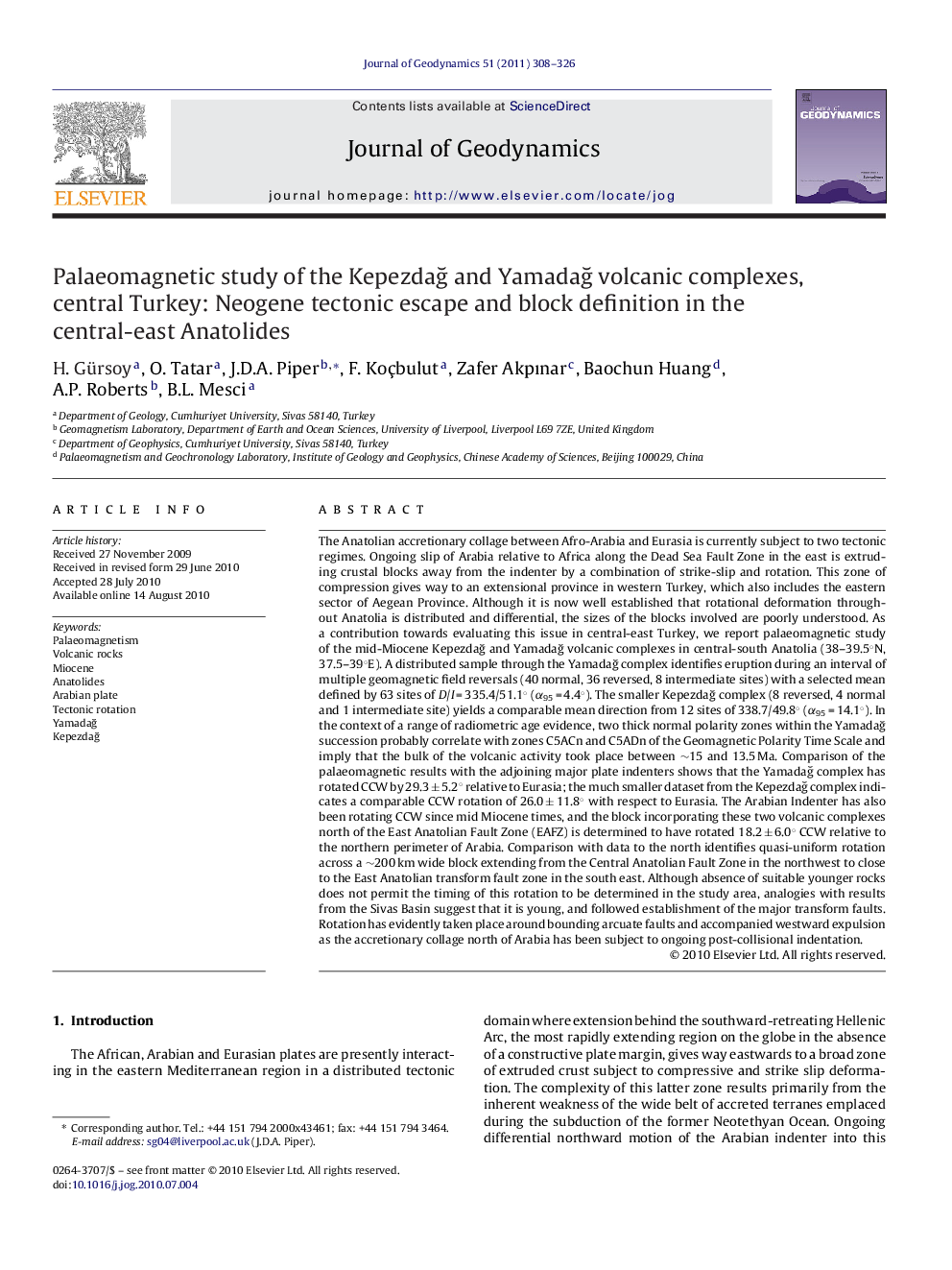| کد مقاله | کد نشریه | سال انتشار | مقاله انگلیسی | نسخه تمام متن |
|---|---|---|---|---|
| 4688436 | 1349845 | 2011 | 19 صفحه PDF | دانلود رایگان |

The Anatolian accretionary collage between Afro-Arabia and Eurasia is currently subject to two tectonic regimes. Ongoing slip of Arabia relative to Africa along the Dead Sea Fault Zone in the east is extruding crustal blocks away from the indenter by a combination of strike-slip and rotation. This zone of compression gives way to an extensional province in western Turkey, which also includes the eastern sector of Aegean Province. Although it is now well established that rotational deformation throughout Anatolia is distributed and differential, the sizes of the blocks involved are poorly understood. As a contribution towards evaluating this issue in central-east Turkey, we report palaeomagnetic study of the mid-Miocene Kepezdağ and Yamadağ volcanic complexes in central-south Anatolia (38–39.5°N, 37.5–39°E). A distributed sample through the Yamadağ complex identifies eruption during an interval of multiple geomagnetic field reversals (40 normal, 36 reversed, 8 intermediate sites) with a selected mean defined by 63 sites of D/I = 335.4/51.1° (α95 = 4.4°). The smaller Kepezdağ complex (8 reversed, 4 normal and 1 intermediate site) yields a comparable mean direction from 12 sites of 338.7/49.8° (α95 = 14.1°). In the context of a range of radiometric age evidence, two thick normal polarity zones within the Yamadağ succession probably correlate with zones C5ACn and C5ADn of the Geomagnetic Polarity Time Scale and imply that the bulk of the volcanic activity took place between ∼15 and 13.5 Ma. Comparison of the palaeomagnetic results with the adjoining major plate indenters shows that the Yamadağ complex has rotated CCW by 29.3 ± 5.2° relative to Eurasia; the much smaller dataset from the Kepezdağ complex indicates a comparable CCW rotation of 26.0 ± 11.8° with respect to Eurasia. The Arabian Indenter has also been rotating CCW since mid Miocene times, and the block incorporating these two volcanic complexes north of the East Anatolian Fault Zone (EAFZ) is determined to have rotated 18.2 ± 6.0° CCW relative to the northern perimeter of Arabia. Comparison with data to the north identifies quasi-uniform rotation across a ∼200 km wide block extending from the Central Anatolian Fault Zone in the northwest to close to the East Anatolian transform fault zone in the south east. Although absence of suitable younger rocks does not permit the timing of this rotation to be determined in the study area, analogies with results from the Sivas Basin suggest that it is young, and followed establishment of the major transform faults. Rotation has evidently taken place around bounding arcuate faults and accompanied westward expulsion as the accretionary collage north of Arabia has been subject to ongoing post-collisional indentation.
Research highlights▶ The Yamadağ and Kepezdağ volcanic complexes were emplaced in mid Miocene times. ▶ Normal and reversed successions define most eruption between 15 and 13 Ma. ▶ The Yamadağ complex identifies ∼30° anticlockwise rotation relative to Eurasia. ▶ Anatolian rotations are differential and involve blocks on a ∼100 km scale. ▶ They result from continuing northward movement of the Arabian indenter.
Journal: Journal of Geodynamics - Volume 51, Issue 5, May 2011, Pages 308–326